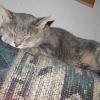Fast, Accurate Collision Detection
I had an idea for a fasy accurate collision detection algo. I requires converting all of the vertexes with there 3d co-ordirdinates to vertexes described as 2 Angles, a distance and for each mesh, and an arbitrary (3d co-ordinate) point. This is where I am not quite sure about implementation, but have a few ideas.
When you go to test a point, (i am from now on going to call the 3d co-ordinate of a vertex the XYZ value and the other the AAD Value, Angle Angle Distance value) you could have a value thaT holds the largest distance between the center of a face to a vertex of that face. Only faces with-in that rage of the tested point would then be tested for interseption. This of course would not be to efficient if there was one huge face and many other small ones, but really I was just giving a basic example of how to restric the detector form test far away faces. Anyways... You would also need two precumputed squares for each face in the mesh, so that by testing if the point''s Angle values lie in that face. I am sorry that I suck at explaining things, but please post a questions or comments.
Sorry again for the lack of explanation value or whatever you''de call that.
Tazzel3D
July 03, 2001 03:52 PM
Let me get this straight... you take a test point and two objects, find the angle that it forms, get the distance between each object and the test point, and based on that find if they collide or not?
How is this significantly different from using a bounding sphere and simply using pythagoras to see if two spheres intersect?
Actually, you would use a basic algo to do some inacurate, but fast collision detection, and then starting from the center of one object, find the first face that is in the range of the angles found from the first clumsy detection. Sorry I can''t explain well, but here is some pesuedo <-(spell?) code:
1. test for basic collision detecton with a fast detector that will serve to limit the number of faces to test accurately
2. starting from the center of one object, test for a face (from either mesh) that is in that angle. If the first face found, is from the mesh other than the one the point is located, they have collided.
1. test for basic collision detecton with a fast detector that will serve to limit the number of faces to test accurately
2. starting from the center of one object, test for a face (from either mesh) that is in that angle. If the first face found, is from the mesh other than the one the point is located, they have collided.
This topic is closed to new replies.
Advertisement
Popular Topics
Advertisement
Recommended Tutorials
Advertisement








